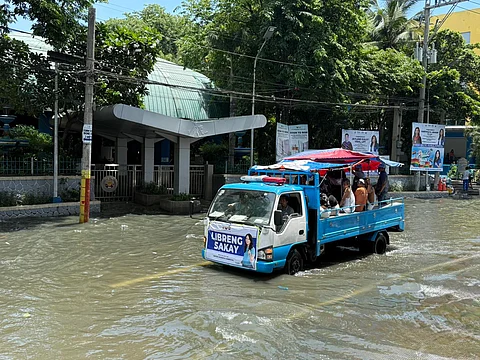
- NEWS
- the EDIT
- COMMENTARY
- BUSINESS
- LIFE
- SHOW
- ACTION
- GLOBAL GOALS
- SNAPS
- DYARYO TIRADA
- MORE

Navotas City and Malabon City, nestled along the coastal fringes of Metro Manila, have long grappled with the relentless challenge of tide flooding. This isn’t just about heavy rains; it’s a daily reality where the ebb and flow of the ocean directly impact urban life, often submerging streets, homes and livelihoods.
For residents there, the tide dictates routines, influencing everything from school commutes to business operations. This persistent battle against rising waters is a defining characteristic of these communities, shaping their resilience and their future.
The phenomenon in Navotas and Malabon is primarily high tide flooding, a consequence of their low-lying topography and proximity to Manila Bay.
Unlike flash floods caused by intense rainfall, tidal flooding occurs when exceptionally high tides, often exacerbated by the “habagat” (southwest monsoon) season and occasional storm surges, push seawater inland. The drainage systems, designed to channel rainwater, become overwhelmed and backflow with saline water, turning streets into canals.
Residents describe a predictable rhythm to the inundation. They know which lunar cycles bring the highest tides and, consequently, the deepest floods. While seemingly benign on a sunny day, the water often carries pollutants and can remain stagnant for hours, even days, after the tide recedes.
This regular exposure to saltwater intrusion takes a heavy toll on infrastructure, corroding roads, foundations, and vehicles, and creating significant public health concerns due to contaminated water.
The human cost of continuous tidal flooding is profound. For families in Navotas and Malabon, preparing for the high tide is a way of life. Furniture is elevated on makeshift stilts, sandbags become common fixtures at doorways, and children learn to navigate submerged pathways from a young age.
Businesses, particularly those reliant on street-level access like sari-sari stores and small eateries, face constant disruption and economic losses. Goods are damaged, customer traffic dwindles, and operating hours are severely curtailed.
The education sector also bears the brunt. Schools in flood-prone areas frequently suspend classes, impacting students’ learning continuity. During particularly severe high tides, school buildings themselves can become inundated, requiring extensive cleanup and repairs. For parents, sending their children to school becomes a daily calculation of safety versus education, often leading to difficult choices.
Beyond the practical challenges, there’s a deep psychological impact. The constant threat of flooding breeds a sense of anxiety and vulnerability. Homes, meant to be sanctuaries, are transformed into spaces susceptible to external forces.
The financial strain of repairs, medical expenses from waterborne diseases, and lost income weigh heavily on households, perpetuating a cycle of hardship, especially for the most marginalized communities.
Despite the relentless nature of the problem, the communities of Navotas and Malabon have developed remarkable resilience and innovative coping mechanisms. Many homes are now built with higher foundations, often featuring concrete stilts or elevated ground floors.
Also, local government units have also invested in pumping stations and dike systems to mitigate the impact, though these solutions are often temporary or insufficient against the most extreme tides.
Community-led initiatives are also vital. Neighborhoods often organize themselves to clear drainage canals manually before high tide events, or to assist vulnerable residents in evacuating during severe floods.
